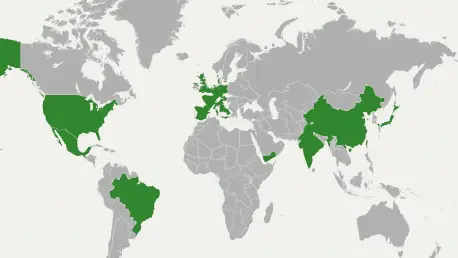In today’s interconnected global economy, the competition to attract foreign direct investment (FDI) through greenfield projects—new ventures that establish physical operations from scratch—has never been fiercer. The Greenfield FDI Performance Index for the current year, derived from data provided by fDi Markets, offers a revealing snapshot of which nations are leading the charge. By measuring a country’s share of global FDI against its share of global GDP, the index identifies overperformers with scores above 1 and underperformers with scores below 1. This analysis delves into the standout nations, regional dynamics, and underlying factors driving success in drawing investment throughout 2024 and into early 2025. From smaller economies outpacing expectations to shifts in investor focus toward sustainable sectors, the patterns emerging from this index paint a compelling picture of how strategic policies and adaptability shape the global investment landscape.
Global Trends in Greenfield FDI Attraction
Overperformance of Smaller Economies
Smaller economies are increasingly making their mark on the global FDI stage by leveraging distinct advantages that larger counterparts often lack. Nations like the UAE and Bahrain stand out with remarkable index scores, demonstrating that a modest GDP does not limit investment appeal. The UAE, for instance, continues to draw significant capital through its strategic geographic position and investor-friendly tax regimes, positioning itself as a hub for diverse industries. Similarly, Bahrain capitalizes on its role as a financial services center, aligning its economic strategies with regional partners to amplify its attractiveness. These countries illustrate how niche strengths can translate into outsized FDI gains, often surpassing expectations based on economic size alone. Their success serves as a blueprint for other small nations aiming to compete in the global market, showing that targeted policies can yield substantial returns.
Beyond strategic positioning, the role of business environment reforms cannot be overstated in enhancing investor confidence across smaller economies. Take El Salvador as a prime example, where recent improvements in security and streamlined regulations have catalyzed a dramatic rise in FDI attraction. Such reforms create a stable foundation that reassures investors, proving that internal changes can have a profound impact even in nations with limited economic heft. This trend underscores a broader theme: proactive governance and adaptability are often more critical than sheer market size. While larger economies may rely on their vast resources, smaller players are finding success by addressing investor needs directly through policy innovation. This dynamic reveals a shifting paradigm in FDI attraction, where agility often trumps scale in securing greenfield projects.
Emerging Investment Priorities
A noticeable shift toward service-oriented and technology-driven investments is reshaping the FDI landscape, offering resilience against traditional trade barriers. Canada exemplifies this trend, maintaining a strong index score by focusing on sectors less vulnerable to tariffs and geopolitical friction. This strategic pivot allows the country to attract record numbers of projects, even amidst external pressures like trade disputes with neighboring economies. The emphasis on services and tech reflects a broader global movement where investors prioritize sectors with high growth potential and lower physical infrastructure demands. This trend not only highlights the evolving nature of FDI but also signals opportunities for nations willing to invest in digital and service-based ecosystems to capture significant capital inflows.
Equally significant is the rising prominence of sustainable and cleantech projects, which are becoming a focal point for global investors. Spain stands as a leading case, securing substantial investments in green energy despite broader regional tensions with key partners like China. This success is often driven by strategic international collaborations that align with global sustainability goals, positioning the country as a frontrunner in an increasingly critical sector. The growing investor interest in cleantech reflects a deeper shift toward environmentally conscious capital allocation, pushing nations to adapt their economic strategies accordingly. As this priority gains momentum, countries that can offer robust frameworks for sustainable projects are likely to see sustained FDI growth, marking a transformative moment in how investment decisions are made on a global scale.
Regional Leaders and Dynamics
Middle East: A Powerhouse of FDI Attraction
The Middle East continues to assert itself as a dominant force in attracting greenfield FDI, with the UAE leading the charge on a global scale. Holding the top spot in the index, this nation draws far more investment than its economic size would suggest, thanks to its business-friendly environment and pivotal role as a regional hub. The UAE’s ability to maintain this position stems from a combination of forward-thinking policies and infrastructure that cater to a wide array of industries. This sustained dominance not only cements its status but also sets a high benchmark for neighboring countries striving to enhance their own investment appeal. The region as a whole benefits from such leadership, as it fosters a competitive yet collaborative environment that drives FDI inflows.
Bahrain also emerges as a standout performer in the region, achieving an impressive index score of 5.8 through its focus on financial and business services. With 31 FDI projects recorded in 2024—the highest since 2017—the country thrives by complementing rather than competing with larger Gulf Cooperation Council (GCC) economies. Other nations like Qatar, Oman, and Saudi Arabia similarly outperform expectations with scores reflecting strong investor interest, while Kuwait and Israel struggle to keep pace. This disparity highlights the varied approaches within the region, where strategic alignment and sector specialization often determine success. The Middle East’s overall strength in FDI attraction underscores the importance of tailored economic strategies in maximizing regional potential.
Western and Northern Europe: Diverse Success Stories
In Western Europe, Monaco captures attention with an index score of 5.9, driven by a record seven FDI projects in 2024, primarily in financial services. Its tax-friendly policies create an irresistible draw for investors seeking stable and lucrative opportunities, showcasing how even the smallest players can excel with the right framework. Meanwhile, Spain and Portugal maintain strong performances, though slight dips in their scores reflect GDP growth outpacing FDI increases. Spain, in particular, secured 669 projects, bolstered by rapid economic expansion and significant cleantech investments from international partners. This blend of traditional and emerging sector strengths illustrates the diverse pathways to FDI success within the region, where adaptability remains a key differentiator.
Northern Europe, led by Ireland with a score of 2.5, demonstrates consistent appeal for a range of investment projects. Finland, the UK, Belgium, Denmark, and Luxembourg also rank highly, reflecting the region’s robust economic environment and innovation-driven policies. Ireland’s leadership is underpinned by a long-standing reputation as a tech and business hub, attracting capital across multiple sectors. The collective strength of these nations highlights Northern Europe’s role as a reliable destination for FDI, even as global economic challenges persist. Their ability to balance traditional industries with cutting-edge opportunities ensures sustained investor interest, positioning the region as a critical player in the global FDI arena.
North AmericContrasting Fortunes
Canada’s performance in North America stands in stark contrast to that of the US, with an index score of 1.5 compared to 0.5, reflecting a significant divergence in FDI attraction. The northern nation’s focus on service-sector investments, which are largely insulated from trade tariffs, has proven to be a winning strategy amid ongoing tensions under recent US administrations. This approach has enabled Canada to secure record FDI projects in the first half of 2025, demonstrating remarkable resilience and strategic foresight. The emphasis on sectors less affected by external trade policies offers a valuable lesson for other economies navigating similar challenges, highlighting the power of targeted investment priorities.
While Canada thrives, the US struggles to attract FDI at a level commensurate with its massive GDP, underscoring that economic size alone does not guarantee success. External pressures, including trade disputes, have hindered its ability to draw greenfield projects, leaving it as an underperformer in the index. This contrast within North America reveals the complex interplay of policy, sector focus, and global dynamics in shaping FDI outcomes. Canada’s adaptability in pivoting to less vulnerable industries provides a stark counterpoint to the challenges faced by its southern neighbor, illustrating the nuanced factors at play in regional investment trends.
Latin AmericRising Stars and Challenges
Costa Rica holds a commanding position as Latin America’s FDI leader and ranks third globally, benefiting from a stable environment and pro-business policies that continue to draw investors. However, emerging threats such as US tariffs and a strengthening currency pose risks to its dominance, signaling potential vulnerabilities despite its high standing. The country’s success is rooted in a consistent ability to create an attractive investment climate, particularly for industries seeking reliable regional bases. Yet, these external pressures highlight the fragility of sustained overperformance, emphasizing the need for ongoing policy adjustments to maintain its edge in a competitive global market.
Elsewhere in the region, El Salvador has engineered a striking turnaround, with its index score jumping to 2.7, a significant improvement attributed to enhanced security measures and business reforms. Peru also shows notable progress with a score of 1.6, while Colombia, Chile, Mexico, and the Dominican Republic report gains, reflecting a broader uptick in investor confidence across Latin America. These developments point to a region on the rise, where targeted improvements can yield substantial results. The diversity of challenges and successes within Latin America underscores the importance of localized strategies in addressing both internal and external factors, paving the way for continued growth in FDI attraction.
Shaping Future Investment Strategies
Reflecting on the insights from the Greenfield FDI Performance Index for this year, it becomes evident that smaller economies often outperform expectations through niche advantages, while regional cooperation and sector-specific strengths play pivotal roles. The UAE’s sustained leadership, Canada’s resilience, and El Salvador’s remarkable progress paint a picture of a dynamic investment landscape shaped by strategic adaptability. Moving forward, nations could focus on cultivating sustainable and tech-driven sectors to align with evolving investor priorities. Policymakers might consider reinforcing business reforms and fostering international partnerships to mitigate external risks like trade tensions or currency fluctuations. As global economic conditions continue to shift, leveraging these lessons from standout performers could guide countries in crafting robust strategies to secure greenfield FDI in the years ahead.









